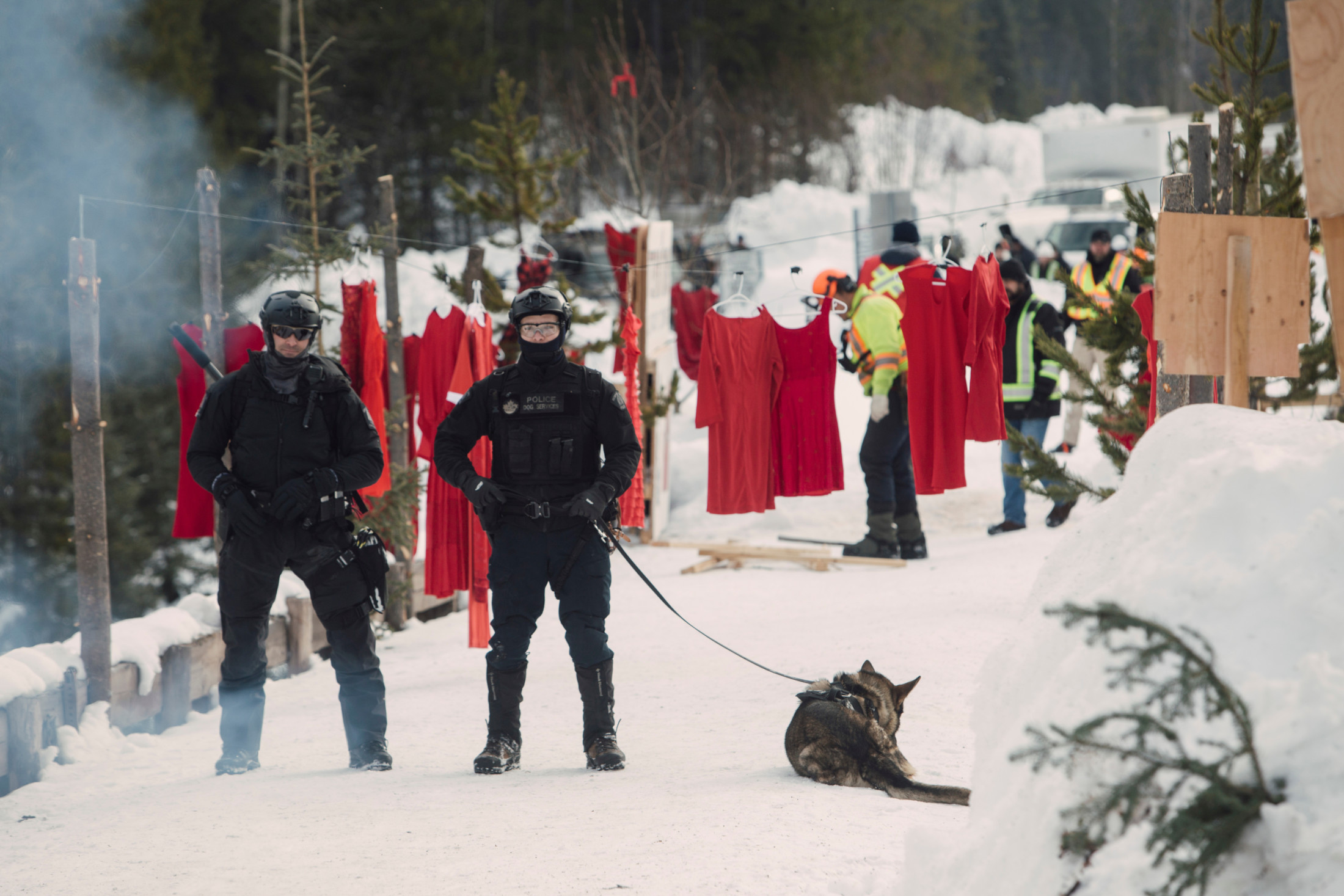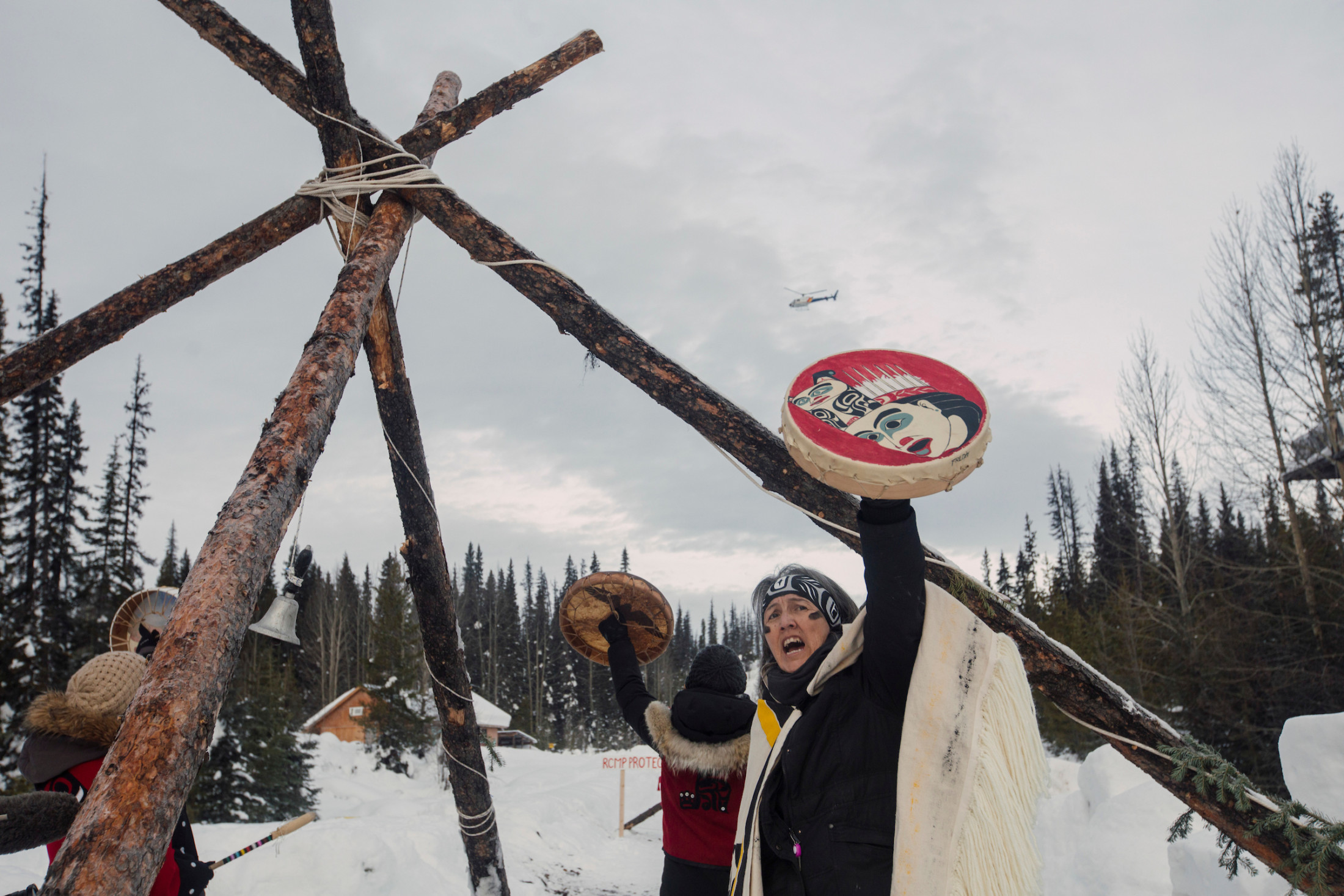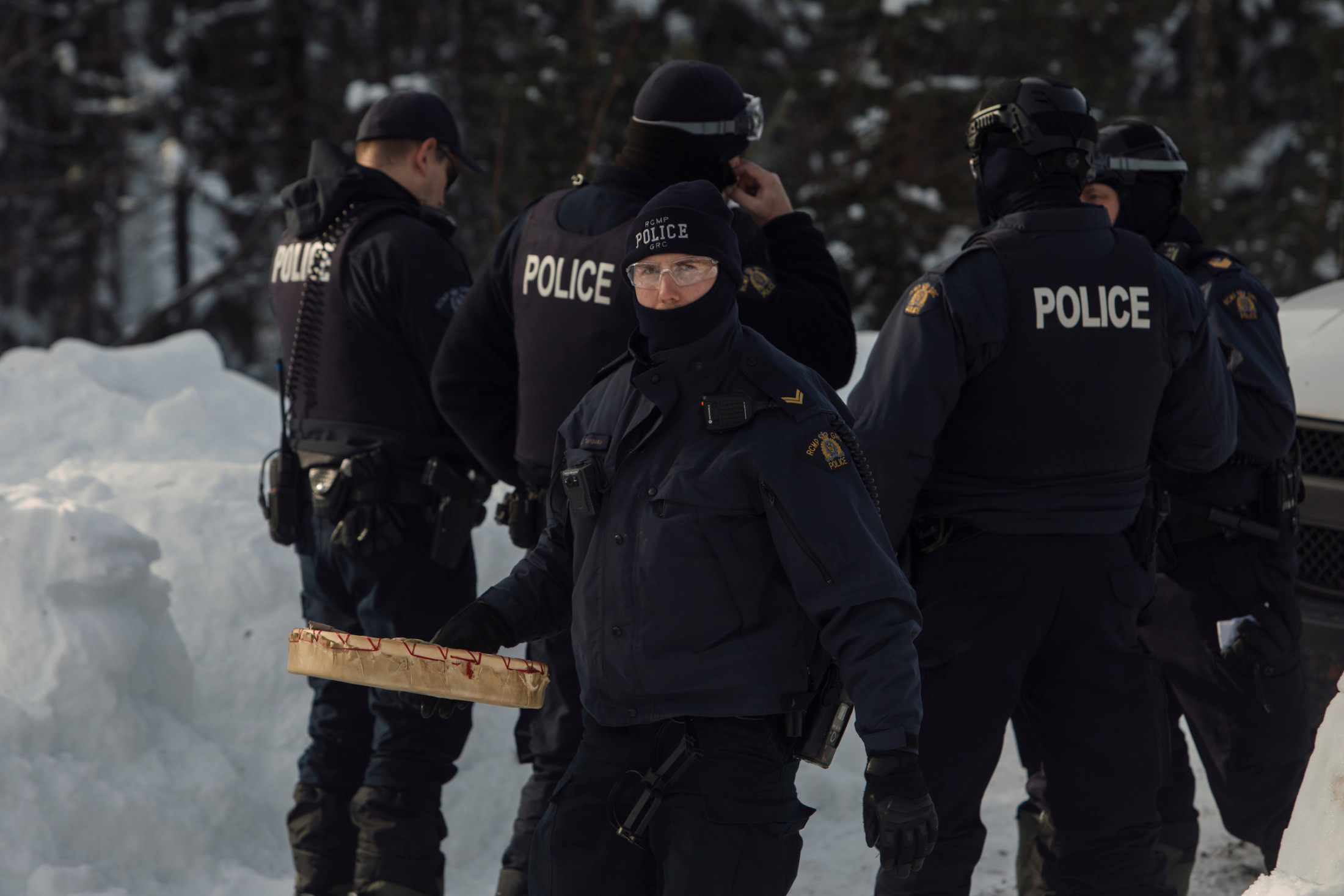
The Right Honourable Mary Simon aims to be an Arctic fox
Canada’s first-ever Indigenous governor general doesn’t play favourites among our majestic natural wonders, but she...
Coastal GasLink cannot legally proceed with pipeline construction activities in the area around the Unist’ot’en healing centre, where Wet’suwet’en nation matriarchs and their supporters were arrested on Monday for defying a court-ordered injunction, the B.C. environment ministry has confirmed.
But the company is permitted to use a bridge leading to the healing centre to bring in heavy equipment for clearing the pipeline right-of-way further west along the Morice River Forest Service Road, the ministry said in an email in response to questions from The Narwhal.
The timber frame Morice River bridge, which provides the only road access to the $2 million healing centre, has been both a physical barrier to pipeline construction and a symbol of resistance against the $6.6 billion Coastal GasLink project, which will supply fracked gas from B.C.’s northeast to LNG Canada’s new export terminal in Kitimat.
For the past several months, red dresses — symbols of the epidemic of violence against Indigenous women and girls — have dangled in the air from lines of suspended wire across the bridge.
Workers in safety vests removed the red dresses Monday morning, along with a tall wooden barricade and a white sign that said “Reconciliation,” as they moved in to arrest matriarchs and others, who drummed and sang in ceremony near the Morice River (Wedzin Kwah).

Members of the RCMP enforce Coastal GasLink’s injunction. Workers can be seen cutting down a makeshift gate positioned along the Morice River Forest Service Road. The workers also removed red dresses, symbols of Canada’s missing and murdered Indigenous Women and Girls from the bridge and Unist’ot’en camp. Photo: Amber Bracken / The Narwhal
The arrests of seven people at the healing centre brought to about 80 the number of arrests of Wet’suwet’en hereditary chiefs, nation members and their supporters, who have blocked access to the Vancouver Port, bridges and railway lines in Ontario and B.C. as part of escalating actions across the country.
In an email in response to questions from The Narwhal, the environment ministry said Coastal GasLink is also permitted to use the Morice River bridge to bring in equipment and workers for development of a 400-person workforce accommodation camp, to transport four-season accommodation trailers destined for the same area and for access to build an “all-weather travel lane.”
Wet’suwet’en hereditary chiefs have requested a judicial review of a decision by the B.C. environmental assessment office to grant an extension of the environmental certificate for the 670-kilometre pipeline, citing more than 50 instances of non-compliance with permits and in light of the findings of Canada’s National Inquiry on Missing and Murdered Indigenous Women.
A final report released from the national inquiry committee last June found “work camps, or ‘man camps,’ associated with the resource extraction industry are implicated in higher rates of violence against Indigenous women at the camps and in the neighbouring communities.”
The healing centre sits in an area known as the Morice River technical boundary area, the subject of a disputed report filed last November by Coastal GasLink as a condition of its provincial environmental assessment certificate.
The report, which details the pipeline’s potential effects on the technical boundary area, fails to include any mention of the healing centre, which received a $400,000 grant from the B.C. First Nations Health Authority to run land-based trauma and addictions treatment programs.
The centre relies on the surrounding wilderness area and incorporates hunting, trapping and other traditional practices into healing programs that help reconnect Indigenous people to the land — programs that psychologist Karla Tait, the centre’s clinical services director, says will not be able to provide their intended benefits if pipeline construction activities proceed and the road leading to the centre is frequented by Coastal GasLink workers.

Freda Huson stands in ceremony while police enforce Coastal GasLink’s injunction. An RCMP helicopter can be seen overhead. Photo: Amber Bracken / The Narwhal
Following a Dec. 31 injunction extension granted by B.C. Supreme Court, which ordered that no one could come within 10 metres of any person or vehicle related to the Coastal GasLink pipeline on Wet’suwet’en territory, the RCMP restricted everyone, including journalists, from coming within 27 kilometres of Gidimt’en camp — one of three camps set up along the Morice River Forest Service Road by Wet’suwet’en hereditary chiefs and their supporters.
The RCMP force has not released a definition of its exclusion zone on Wet’suwet’en territory. Nor has it released a map outlining the area included in the zone.
Gavin Smith, a lawyer with West Coast Environmental Law, pointed to legal questions surrounding the exclusion zone.
“The injunction order itself doesn’t create an exclusion zone,” Smith told The Narwhal. “That’s the RCMP using their enforcement powers to create that exclusion zone.”
On Monday, the B.C. Civil Liberties Association and the Union of B.C. Indian Chiefs amended a complaint they had filed to the
Civilian Review and Complaints Commission for the RCMP, asking the commission to initiate a public-interest investigation into the RCMP’s expanded exclusion zone on the Morice West Forest Service Road, which runs past the healing centre.
The Morice West Forest Service Road begins at kilometre 44 of the forest service road, where the Gidimt’en camp was cleared by RCMP officers on Feb. 7 and four people were arrested. Two people refused to leave the Gidimt’en camp and remain in a cabin there, according to a report from The Tyee.
“There is absolutely no legal precedent nor established legal authority for such an overbroad policing power associated with the enforcement of an injunction,” Harsha Walia, executive director of the B.C. Civil Liberties Association, said in a statement.
“The RCMP have given themselves the power to clear more than 60 kilometres of roadway [belonging to] all people: a power which is not granted to them under the enforcement order. This a clear exercise of overbroad policing power, with the impact of unlawfully criminalizing Indigenous people on their lands and perpetuating the colonial doctrine of terra nullius.”
Terra nullius is the doctrine that land was not occupied when colonial powers arrived, thus justifying occupation.

A police officer carries a drum after RCMP arrested Wet’suwet’en matriarchs. Photo: Amber Bracken / The Narwhal
The two organizations told the RCMP commission that there is absolutely “no legal precedent nor established legal authority for such an overbroad policing power associated with the enforcement of an injunction.”
“The implementation and enforcement of the RCMP exclusion zone in Wet’suwet’en territory is unlawful.”
Grand Chief Stewart Phillip, president of the Union of B.C. Indian Chiefs, said the police exclusion zone denies Wet’suwet’en people access to their own territories and “smacks of outright racism and the colonial-era pass system sanctioned by the so-called rule of law.”
Smith said police action has to be for a recognized legal purpose and has to be compliant with the Canadian constitution and other legal responsibilities.
“As we’ve seen with the B.C. civil liberties complaint, it’s an open question as to whether that exclusion zone is overreaching,” he said.
“The Supreme Court has been quite clear that if you don’t actually have a statute that is saying ‘here’s the law you’re enforcing, the criminal code,’ or you don’t actually have a court order that’s explicitly saying that you can create an exclusion zone — which the Coastal GasLink injunction does not — then there’s only really a narrow pocket of the law that police can rely on to interfere with individual liberty, because they have to do so in a way that’s for a lawful purpose and doesn’t unduly interfere with individuals’ rights.”
B.C.’s Environmental Assessment Office must accept the Morice River technical boundary report before Coastal GasLink receives authorization to proceed with construction in that area.
Last week, the environment ministry told The Narwhal the environmental assessment office is in the process of reviewing the report, a process that includes consultation with Wet’suwet’en hereditary chiefs.
If the office deems the report unsatisfactory, Coastal GasLink must go back to the drawing board and re-submit the report, a process that could take up to several months.
Even though the company cannot proceed with construction activities inside the technical boundary area, including around the Unist’ot’en healing centre, it is “currently able to access and proceed with non-construction activities” within the technical boundary area and to proceed with construction activities in all areas outside the boundary, the ministry said.
Smith said the environmental assessment office has a suite of tools at its disposal if Coastal GasLink breaches the conditions of its environmental assessment certificate and commences construction activities in the Morice River technical boundary area. Those tools include the ability to issue a stop work order, he said.
“I would hope and expect that there’s a lot of clear monitoring that’s going on about what’s being done with that equipment and where it’s going,” Smith said.
“Obviously everyone has an interest in ensuring CGL is not stepping beyond the bounds of its environmental assessment approval.”
Get the inside scoop on The Narwhal’s environment and climate reporting by signing up for our free newsletter. A $335 million funding commitment to fund...
Continue reading
Canada’s first-ever Indigenous governor general doesn’t play favourites among our majestic natural wonders, but she...

In Alberta, a massive open-pit coal mine near Jasper National Park is hoping to expand...

A trade war could help remake B.C.’s food system, but will family farmers be left...
